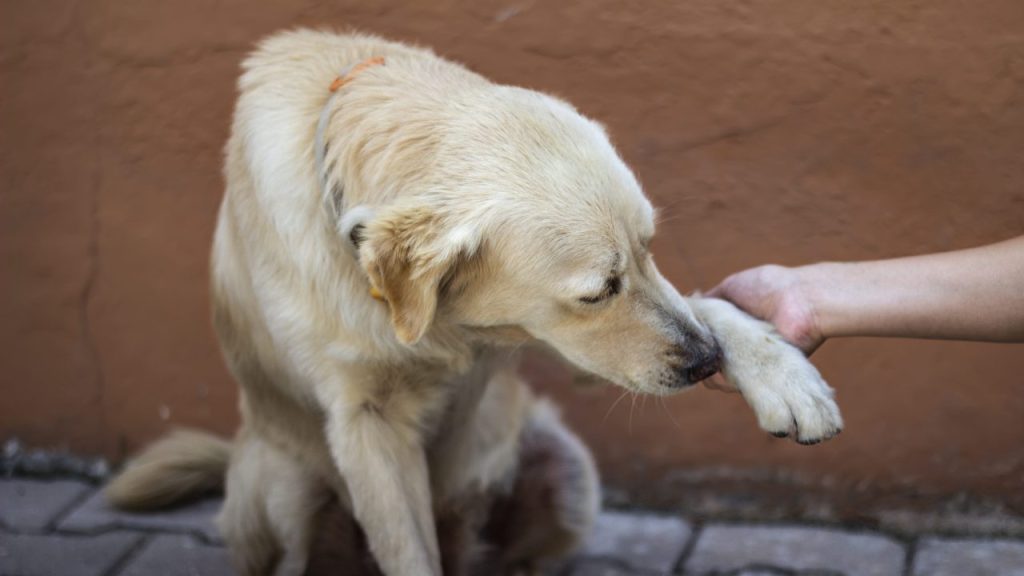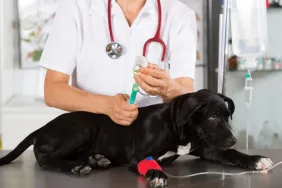Bee stings can be just as scary for your four-legged friends as it can be for you. Bees are most active in the summertime. This is when they seek out food for the hive, pollinate plants, or move a queen to a new location in a swarm. Getting stung by a bee, especially on the foot, can be painful, and in some cases may require veterinary care. Knowing what to do if your dog has stepped on a bee can help keep your pup safer when playing outdoors.
Signs that your dog stepped on a bee
Bee stings and wasp stings contain a venom that causes localized swelling at the site of the sting. It also causes a lot of pain. When a bee stings, the stinger breaks free, lodging itself into the location of the sting. This is different from the stings of wasps, whose stingers stay attached, allowing for multiple strikes.
If your dog has stepped on a bee, you’ll likely see localized swelling of the toes, foot, ankle, and paw pad. Your dog may also yelp in pain or lay down to lick at the stinger lodged in their paw. There will also be redness around the site of the sting. In addition, your dog may attempt to nip or yelp if the painful parts are touched.
How to treat a bee sting
In most cases, bee stings can be treated at home. The first step is to check for the presence of a stinger and to remove it. It’s best to gently scrape the stinger away instead of tweezing it. Tweezers can inject more of the stinger’s contents into the injury — leading to more pain and swelling.
Next, a cold pack can be used to help reduce localized swelling and reduce pain. Monitor your dog while using the cold pack to avoid accidental ingestion. Then, remove the pack after 15 minutes to avoid injury to the area. An over-the-counter antihistamine, such as Benadryl, can also be used to treat localized swelling and allergic reactions. However, if your pet has a severe reaction to a sting, it’s best to seek veterinary help.
When to seek veterinary care for a bee sting
It’s best to seek veterinary care right away if your dog is having a severe allergic reaction to a sting. It’s also important to seek care if they’ve been stung multiple times over their body. Signs of a severe allergic reaction include swelling of the face, head, or neck — all of which require immediate emergency care. Other severe allergy symptoms include vomiting, diarrhea, and lethargy. If the sting site doesn’t heal or begins to look infected, it should also be seen by your vet.
Your vet will likely inject several fast-acting antihistamines during your visit to help reduce the swelling caused by the allergic reaction. They may also recommend steroid injections to stop the immune response, or an IV to help administer more medications and fluids as needed.
How to prevent bee stings
Luckily, there are a few ways you can help your dog avoid stepping on a bee. If you’re outdoors, keep an eye on your dog, especially if they’re in areas frequented by bees such as grassy fields of flowers or wasp nests. If you’re having a picnic or outdoor event, take measures to avoid attracting bees by keeping food secure and covered. Also, be sure to dispose of trash away from the activity. Avoiding scented sprays on you or your dog can also keep curious creatures from venturing too close.
If your dog has stepped on a bee — don’t panic! By taking action to quickly treat any stings and monitoring your dog for signs of a more severe allergy, you can make sure they have a safe, swift recovery. If you’re looking for more ways to keep your dog safe this summer, check out the top summer dangers to avoid. Or, follow these top summer safety tips to keep your next outing safe and enjoyable.









